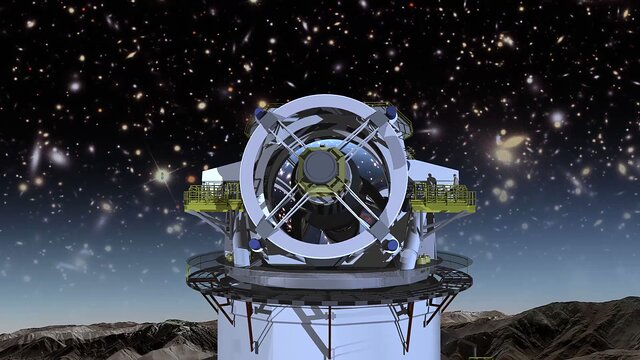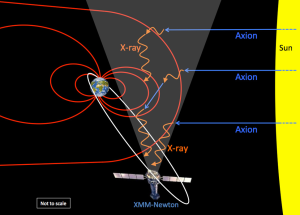Rubin Telescope: Mapping Dark Matter and the Milky Way
The Rubin Telescope, housed at the Vera C. Rubin Observatory in Chile, is set to revolutionize the field of astronomy with its unparalleled capabilities. As part of the Legacy Survey of Space and Time (LSST) project, this powerful telescope is designed to conduct astronomical observations that will illuminate the mysteries of dark matter and map the intricate structure of our Milky Way. Equipped with the pioneering LSST Camera, the Rubin Telescope is optimized for cosmic cinematography—a technique that allows for a comprehensive analysis of the universe’s celestial bodies. By capturing images of the night sky every few nights for a decade, it promises an in-depth exploration of transient phenomena and potential discoveries of new astronomical events. The groundbreaking data generated by the Rubin Telescope will undoubtedly be a treasure trove for scientists, educators, and the broader public, fostering a new era of discovery in astrophysics.
At the forefront of modern astronomical exploration, the Vera C. Rubin Observatory’s advanced telescope system is poised to redefine our understanding of the cosmos. Known for its innovative approach, this instrument aims to carry out a decade-long survey of the sky, utilizing a state-of-the-art imaging system to capture a vast array of celestial phenomena. With its focus on mapping our galaxy and unraveling the enigma surrounding dark matter, the observatory is a pivotal player in what many are calling the next leap in cosmic exploration. The project harnesses wide-field imaging technology to facilitate an extensive examination of the universe, creating opportunities for groundbreaking research and education. Through its combined efforts in data collection and public engagement, the observatory promises to unravel deep cosmic mysteries while accessible to scientists and students alike.
The Rubin Telescope: A New Era in Astronomy
The Rubin Telescope, formally known as the Vera C. Rubin Observatory, stands at the forefront of astronomical innovation. Funded by the U.S. National Science Foundation and the Department of Energy, this ambitious project aims to revolutionize the way astronomers observe the cosmos. Through a unique combination of a large aperture and wide field of view, the Rubin Telescope will enable unprecedented surveys of the night sky, capturing detailed images that could lead to remarkable discoveries in our understanding of the universe.
As the Rubin Telescope gears up for its ten-year Legacy Survey of Space and Time, the excitement among the scientific community is palpable. With its advanced imaging capabilities, including the integration of the groundbreaking LSST Camera, the project promises to illuminate a wealth of astronomical phenomena, from transient events like supernovae to the elusive nature of dark matter. As astronomers look forward to the first public release of images by mid-2025, the potential for groundbreaking research has never been greater.
Frequently Asked Questions
What is the Rubin Telescope and its main purpose?
The Rubin Telescope, officially known as the Vera C. Rubin Observatory, is designed for the Legacy Survey of Space and Time (LSST). Its main purpose is to create a comprehensive map of the night sky over a 10-year period, enabling astronomers to make groundbreaking discoveries related to dark matter, the structure of the Milky Way, and other cosmic phenomena.
How does the LSST Camera enhance observations with the Rubin Telescope?
The LSST Camera, the largest astronomical camera ever constructed, is crucial for the Rubin Telescope as it provides high-resolution images 21 times larger than those captured by the test camera. This capability allows for detailed astronomical observations, contributing to projects like cosmic cinematography and extensive mapping of the Milky Way.
What role does the Rubin Telescope play in understanding dark matter?
The Rubin Telescope will significantly advance our understanding of dark matter by capturing precise data through its LSST Camera. It aims to observe the gravitational effects of dark matter within the Milky Way, helping to address fundamental questions about its nature, which constitutes a significant portion of the universe’s mass.
What are the expected outcomes of the Rubin Telescope’s 10-year survey?
Over its 10-year survey, the Rubin Telescope is expected to generate a time-lapse image of the night sky, documenting changes and movements of celestial objects. This data will help in detecting potentially hazardous asteroids, mapping the Milky Way’s structure, and exploring fundamental physics questions related to dark matter and dark energy.
How will the data from the Rubin Telescope be made available to the public?
The data collected by the Rubin Telescope will be made fully accessible to the scientific community and the public. The observatory plans to facilitate educational outreach programs for K-12 students, ensuring that findings are available for both formal research and informal education.
What innovations does the Rubin Telescope bring to astronomical research?
The Rubin Telescope introduces innovative concepts such as wide-field imaging combined with large-aperture capabilities, allowing astronomers to explore a wide range of faint celestial objects simultaneously. This approach transforms traditional astronomical research and opens new avenues for discovery.
How will the Rubin Telescope change astronomical observation methods?
The Rubin Telescope shifts astronomical observation methods from a focus on specific celestial targets to a comprehensive, wide-field imaging strategy. This transition enables researchers to observe multiple phenomena, such as supernovae and asteroids, thereby expanding the scope of the science conducted with its powerful LSST Camera.
What is cosmic cinematography as it relates to the Rubin Telescope?
Cosmic cinematography refers to the ability of the Rubin Telescope to capture and process vast amounts of imagery over time, creating a dynamic record of the night sky. This technique will allow astronomers to observe transient events, such as supernovae and asteroid movements, providing a unique perspective on cosmic changes.
When can we expect to see the first astronomical images from the Rubin Telescope?
The first set of astronomical images from the Rubin Telescope is anticipated to be released to the public in mid-2025, following a commissioning period once the main LSST Camera is installed and tested.
What scientific questions will the Rubin Telescope help answer?
The Rubin Telescope is positioned to address critical scientific questions about dark matter, the expansion of the universe influenced by dark energy, and the overall structure of the Milky Way. Its extensive observational capabilities will provide crucial data needed to explore these fundamental topics in astrophysics.
| Key Point | Details |
|---|---|
| Rubin Telescope Overview | The Vera C. Rubin Observatory is set to create a comprehensive map of the universe over a 10-year period. |
| Test Camera Success | The test camera captured its first on-sky images, confirming operational status of the telescope and software frameworks. |
| Main Camera Integration | The LSST Camera, the largest astronomical camera ever, will be integrated with the telescope to capture significantly larger images. |
| Data Accessibility | All data will be immediately available for scientists and educational outreach from K-12. |
| Scientific Goals | The project aims to explore dark matter, dark energy, and other cosmic phenomena, revolutionizing how astronomical data is approached. |
Summary
The Rubin Telescope is a groundbreaking initiative poised to transform our understanding of the universe. By integrating advanced technology with open data principles, it will provide unprecedented insights into celestial dynamics over a decade-long study. With its powerful LSST camera, the observatory aims not only to map the Milky Way but also to explore deep questions about dark matter and dark energy, paving the way for future discoveries in astrophysics.



